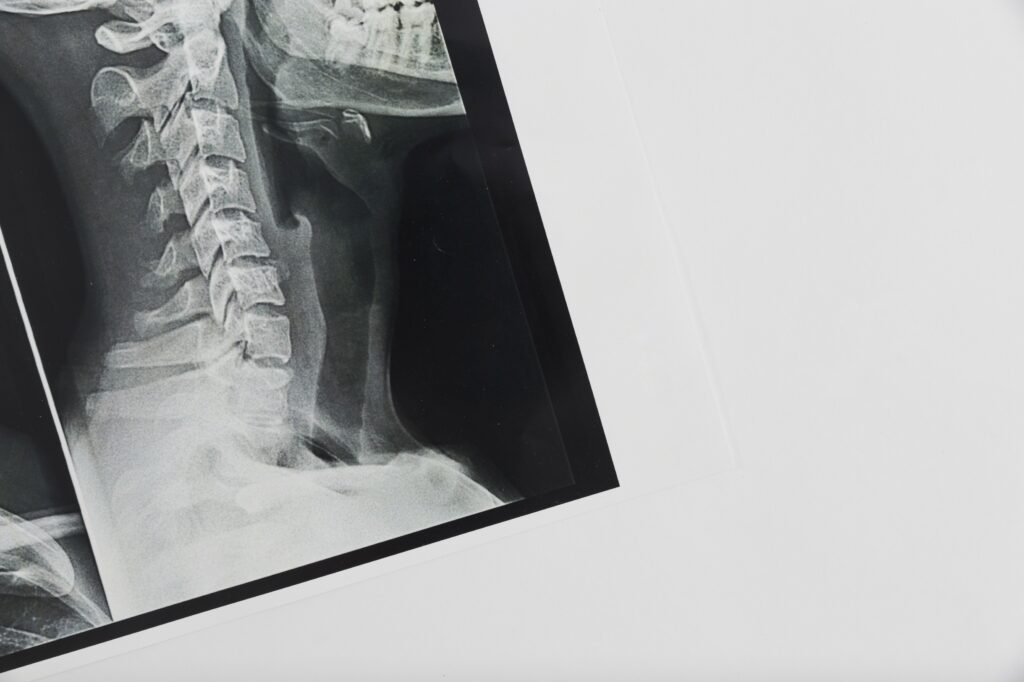By Farhan Malik, MD
Atlanta Innovative Medicine
Cervical instability, a condition characterized by the abnormal movement of the cervical spine, poses significant, far-reaching, and often surprising challenges for those affected. In this guide, we dig into some of the nuances of this complex condition, offering considerations for diagnosis and treatment.
Cervical instability, which is essentially misalignment in the neck, can have implications extending far beyond neck pain and stiffness. When ligaments in the cervical spine weaken or become overstretched, the delicate balance of the spine becomes compromised, leading to a range of symptoms throughout the body and its systems, from headaches and arm pain to brain fog and cognitive decline.
Throughout this blog, we’ll explore the various facets of cervical spine instability, from its underlying causes to its impact on daily life. We’ll discuss the challenges of diagnosis, the importance of accurate assessment, and the best treatment options available, including regenerative procedures available here at AIM.
What is cervical instability?
Cervical instability, also called clinical instability of the cervical spine (CICS), refers to a condition in which the ligaments of the cervical spine become loose or overstretched, allowing an abnormal range of movement (or neck hypermobility) which causes spinal misalignment and neck instability.
In an effort to make up for the lost spinal support, surrounding muscles become strained, causing weakness, stiffness, and pain. Spinal misalignment also compresses and irritates the spinal nerves which can cause radiating pain throughout the body, as well as a wide range of neurological symptoms, from nausea and vertigo to vision problems.
What is the anatomy of cervical instability?
The cervical spine refers to the top portion of the spine that runs from the base of the skull down through the base of the neck, where it meets the thoracic spine. Because of its critical position at the base of the head and in proximity to the brain, the cervical spine has many responsibilities. It provides support and flexibility for the head’s movements while also ensuring the protection of the delicate spinal cord.
It fulfills these roles by forming a spinal canal that surrounds the spinal cord: seven vertebrae (C1–C7) are aligned one on top of the other, separated by intervertebral discs, connected by joints, and held together by internal and external ligaments.
When these ligaments become stretched or weakened, they cannot keep the vertebrae in place to maintain the natural curvature of the spine.
As the vertebrae fall out of alignment, the muscles in and around the neck attempt to compensate for the instability, leading to fatigue and soreness. As the curvature of the spine becomes distorted, the nerves become compressed where they exit the spinal canal, resulting in the complex of symptoms often associated with cervical instability.
What is the anatomy of craniocervical instability?
Cervical instability that involves the top two vertebrae (C1 and C2) is often referred to as craniocervical instability or upper cervical instability, and it tends to cause more severe symptoms and greater neurological risks. The C1 and C2 vertebrae are part of the craniocervical junction—the complex structure that protects the spinal cord where it meets the base of the brain stem.
A structural problem here can cause compression of or other injury to the brainstem, cranial nerves, cranial blood vessels, and spinal cord. This kind of disruption near the brain can lead to severe and widespread neurological disruptions, affecting functions like sensation, movement, and even organ function.

What are the most common neck instability symptoms?
Because cervical instability often impacts both the musculoskeletal and central nervous systems, symptoms can show up in various body systems and all throughout the body. Depending on the root cause, which region of the cervical spine is affected, and to what degree, the symptoms of cervical instability vary widely between individual patients.
While reported symptoms extend beyond this list, these are some of the most common types of neck pain and neurological symptoms among patients with cervical instability:
- Difficulty holding the head up
- Headaches or migraines
- Muscle spasms
- Neck and shoulder soreness
- Radiating pain in the shoulders, arms, or hands
- Numbness or tingling in the arms or hands
- Weakness or clumsiness in the arms or hands
- TMJ
- Light sensitivity
- Blurred vision
- Vertigo
- Tinnitus
- Dizziness
- Nausea
- Difficulty swallowing
- Rapid heart rate
- Skin rash, irritation, or other odd sensations
- Fatigue
- Memory loss
- Cognitive decline
What does cervical instability feel like?
Neurological symptoms associated with cervical instability, especially craniocervical instability, can be particularly challenging to describe and quantify. Unlike more tangible physical symptoms, such as muscle weakness or soreness, neurological symptoms can present as unusual sensations that vary widely among individuals. These sensations can be difficult to articulate, making it hard for patients to see themselves reflected in generic symptoms or to convey their experiences to healthcare providers effectively.
Here are some ways the neurological symptoms of cervical instability are often described:
Heaviness and movement in the neck:
- My neck gets stuck or locks with movement.
- When I turn my neck, it pops or clicks.
- My head feels heavy.
- My head feels like a bobble head.
- My neck feels empty.
- I get tired of holding my head up.
- External support from a collar or my hands helps.
- It’s uncomfortable after being in one position for long.
Weakness and pain:
- Shaky
- Unstable
- Out of control of my body
- Clumsy
- Sharp pains
- Burning sensations
- Pins and needles
Odd Sensations in the skin
- Itching
- Bugs crawling on my skin
- Tingling
Do these symptoms sound familiar?
Book an appointment to learn how we can help you identify and treat the cause of your symptoms.

Is cervical instability dangerous?
The likelihood of serious complications from cervical instability depends on various factors, including the underlying cause and which vertebrae are destabilized. While some individuals may experience minimal impact, others may face significant risks.
Upper cervical instability in particular can lead to serious complications, including neurological impacts and compromised blood flow to the brain. When vital structures like the brainstem, spinal cord, nerves, and blood vessels become compressed, nerve damage and disrupted blood flow can result in complications including strokes, transient ischemic attacks, and neurological deficits. Early recognition and appropriate management are crucial to minimize these risks.

What causes cervical instability?
The cervical spine plays a crucial role in supporting the weight of the head and facilitating its range of motion. To do this, it trades off a degree of structural strength, making it susceptible to injury and destabilization. Some of the most common causes of destabilization include trauma, degenerative diseases, inflammatory conditions, and congenital abnormalities.
Trauma
Trauma, commonly auto accident whiplash or sports-related impacts, can significantly compromise the structural integrity of the cervical spine. The abrupt, forceful back-and-forth motion experienced during whiplash can lead to ligament damage and vertebral misalignment. Similarly, direct trauma to the neck area can result in ligament sprains, tears, or fractures. Even if a traumatic injury is mild, it can weaken the ligaments, leading to cervical instability over time.
Degenerative and Inflammatory Diseases
Rheumatoid Arthritis:
Rheumatoid arthritis is an autoimmune disorder that causes chronic inflammation in the tissues surrounding the joints, resulting in repeated stretching of the joints’ ligaments. When this inflammation happens in the craniocervical junction, the ligaments stabilizing the C1 and C2 vertebrae become lax, leading to craniocervical instability and possible damage to the cranial blood vessels and central nervous system.
Cervical Spondylosis:
Degenerative disc disease, or spondylosis, is a condition characterized by the wear and tear of spinal discs and facet joints, weakening the supportive structures of the spine and increasing susceptibility to instability. When the intervertebral discs in the cervical spine degenerate, misalignment and abnormal movement patterns can lead to cervical instability.
Congenital Abnormalities
Congenital abnormalities, including conditions like Down syndrome (trisomy 21), can predispose individuals to cervical instability. Structural anomalies in the cervical vertebrae or ligaments may be present from birth, compromising the stability of the cervical spine. In the case of Down syndrome, the C1 and C2 vertebrae are not properly stabilized, causing craniocervical instability.
How do you test for cervical instability?

Diagnosing cervical instability can be challenging due to its nonspecific symptoms that mimic those of other common musculoskeletal and neurological conditions. Because symptoms can be easily attributed to aging or other unrelated factors, cervical instability is frequently overlooked and misdiagnosed.
Fortunately, when both patient and doctor are aware of this possible diagnosis and have a thorough understanding of the patient’s symptoms, there are a few tests that can help secure an accurate diagnosis.

Subscribe for Expert Insights and Our Ebook
A Closer Look at Regenerative Medicine: Comparing Your Options Learn about treatment options like Platelet Rich Plasma (PRP), Prolozone Therapy, and Stem Cell Therapy.
Imaging Studies: X-rays, MRI, and CT scans can provide detailed images of the cervical spine, revealing abnormalities such as ligament laxity, spinal misalignment, or disc herniation.
Dynamic Imaging: Dynamic imaging techniques, such as flexion-extension X-rays, assess the stability of the cervical spine during movement, helping to identify instability or abnormal motion patterns.
Neurological Evaluation: Neurological testing, including EMG and nerve conduction studies, may be performed to assess nerve function and identify cervical radiculopathy caused by abnormalities or compression.
Specialized Testing: In cases of suspected craniocervical instability, specialized testing such as upright MRI or cine MRI may be utilized to evaluate the dynamic motion of the craniocervical junction.
Physical Examination: A physical examination may include assessing neck range of motion, muscle strength, reflexes, and sensory function.
By combining these diagnostic tests with a thorough assessment of the patients’ medical history and symptoms, healthcare providers can effectively evaluate cervical instability and develop a tailored treatment plan to address the underlying issues and alleviate symptoms.

How is cervical instability treated?
Treating cervical instability varies depending on the underlying causes at play. In the case of trauma or congenital abnormality, treatment will focus on structural corrections, while cervical instability caused by conditions like rheumatoid arthritis will typically involve condition-specific treatments as well. Either way, in most cases, treatment involves a combination of conservative treatments to strengthen ligaments and correct misalignments in the cervical spine.
In cases where conservative measures fail to provide relief or when instability is severe, surgical intervention involving posterior fixation techniques may be considered. It’s essential to note that these surgical procedures carry major risks, including the risk of spinal cord injury, and should be carefully considered and discussed with a healthcare provider.
How do you fix cervical instability?
For most patients with cervical instability, the safest and most conservative treatment involves a combination of manual therapies and regenerative therapies, particularly prolotherapy.
Physical therapy helps target and strengthen specific muscles that help stabilize the cervical spine, decreasing stress on the compromised vertebrae. Research has demonstrated the effectiveness of physical therapy in improving neck strength, range of motion, and overall function in patients with cervical instability.
Chiropractic adjustments help to restore the natural curvature of the cervical spine and reduce imbalance forces or pressure on surrounding muscles, ligaments, and nerves that cause pain and other symptoms associated with cervical instability.
Prolotherapy involves injecting a natural irritant solution into the affected ligaments and tendons to stimulate the body’s natural healing response and promote tissue repair. Studies have shown promising results with prolotherapy in improving pain and function in patients with cervical instability.

How do you prevent cervical instability?
Preventing cervical instability involves identifying and managing risk factors and implementing lifestyle modifications to promote spinal health and stability. While some risk factors, such as congenital conditions or traumatic injuries, may be nonmodifiable, others, such as poor posture, can be addressed through proactive measures.
In either case, regular monitoring, early detection of symptoms, and appropriate treatment can help manage the effects of risk factors and prevent complications associated with cervical instability.
Poor Posture and Ergonomics: Maintaining proper posture and ergonomic practices can help prevent cervical instability associated with chronic strain. Simple adjustments, such as maintaining a neutral neck position while sitting or standing, using ergonomic furniture and equipment, and taking regular breaks to stretch and move, can reduce strain on the cervical spine and promote spinal alignment.
Repetitive Movements: Limiting repetitive movements or activities that exert excessive stress on the neck can help prevent cervical instability. When engaging in tasks that involve repetitive motions, such as typing or lifting, taking frequent breaks and varying movement patterns can distribute stress more evenly across the cervical spine, reducing the risk of strain and instability.
Muscle Weakness and Imbalance: Strengthening and conditioning the muscles surrounding the cervical spine can build a supportive framework that reduces the risk of cervical instability. Incorporating exercises that target neck, shoulder, and upper back muscles, as well as core stabilization exercises, can improve spinal support and alignment, reducing the likelihood of instability-related symptoms.
Sedentary Lifestyle: Leading a sedentary lifestyle can contribute to muscle weakness and poor posture, increasing the risk of cervical instability. Engaging in regular physical activity, such as walking, swimming, or yoga, can promote spinal health and mobility.

Cervical instability treatment & prevention at Atlanta Innovative Medicine
At AIM, we pride ourselves on our multidisciplinary approach to cervical instability treatment and prevention. We prioritize accurate diagnosis and root cause treatment, recognizing that each patient’s condition is unique and requires personalized care. By utilizing advanced diagnostic techniques, we help uncover underlying issues contributing to cervical instability, allowing us to tailor our treatment approach accordingly.
Our treatment plans often combine a variety of noninvasive management strategies aimed at addressing both the symptoms and underlying causes of cervical instability. This may include a combination of physical therapy, chiropractic adjustments, and prolotherapy, alongside other therapeutic and regenerative techniques that strengthen the body’s inherent ability to heal itself.
At AIM, our ultimate goal is to empower our patients to take control of their health and wellbeing. Whether you suspect cervical instability or recognize risk factors and want to prevent it, our multidisciplinary clinic is here to help. Our team of experts is dedicated to providing comprehensive care that focuses on both proactive and responsive treatment.
Contact us today to learn how we can support you toward optimal spinal health and function!
Quizzes
Are you a candidate for Regenerative Medicine?
Regenerative medicine can be an effective therapy and treatment option for lasting pain relief for a variety of conditions like osteoarthritis of the knee, hip or shoulder; ACL or meniscus tears; tennis or golfer’s elbow; chronic neck and back pain; and more.
Is it right for you and your condition? Take 1 minute to answer a few “yes or no” questions that help to assess if you might be a candidate for PRP, stem cell or other nonsurgical regenerative treatments.
Are You a Stem Cell Candidate for Your Joint or Spine Damage?
Are you a candidate for Platelet Rich Plasma (PRP) Therapy?
Do I have nonsurgical options for my injured or aging joints?
Take the Pain Medications Risk Quiz

Regenerative Medicine.
Reimagined
- Advanced hybrid therapies, including Mesenchymal Stem Cell therapy combined with different mechanisms of action that synergistically come together to support ultimate healing
- More powerful PRP that’s customized, amplified and personalized
- Therapies delivered by an experienced, compassionate team comprised of multidisciplinary experts in traditional and alternative medicine working as your team: Medical Doctors, Nurse Practitioners, Physiotherapists and Chiropractors
- Advanced training through the American Academy of Orthopedic Medicine, the American Osteopathic Association of Prolotherapy Regenerative Medicine, and more
All content of this page is for informational purposes only and is not intended to serve as a substitute for the consultation, diagnosis, and/or medical treatment of a qualified physician or healthcare provider. Individual results may vary. Your medical professional can explain all the risks and potential benefits of any therapy based on your specific circumstances. At this time regenerative therapies are not FDA approved. Neither Atlanta Innovative Medicine nor its physician affiliates promise regenerative therapies as a cure for any condition, disease, or injury.
Other Atlanta Areas We Service:
© 2024 Atlanta Innovative Medicine, LLC. All Rights Reserved. AIM Scholarship Opportunity








